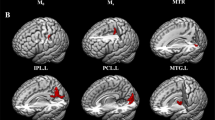Abstract
Introduction
Fast spin-echo (FSE) T1-weighted (T1W) magnetic resonance imaging (MRI) at 3T, which is sensitive to neuromelanin-related contrast, can quantitatively detect signal alterations in the locus ceruleus (LC) and the substantia nigra pars compacta (SNc) of depressive and schizophrenic patients; however, its qualitative diagnostic performance remains unknown. We investigated whether visual interpretation of semiquantitative color maps can be used for discriminating between depressive and schizophrenic patients and healthy individuals.
Methods
We retrospectively examined 23 patients with major depression, 23 patients with schizophrenia, and 23 age-matched healthy controls by using a FSE-T1W MRI technique. Semiquantitative color maps of sections through the LC and SNc were visually interpreted by nine raters using a continuous confidence rating scale for receiver operating characteristic (ROC) analysis.
Results
The area under the ROC curve (Az), which reflects the performance in differentiating between depressive patients and controls, was 0.88, and the sensitivity and specificity at the maximum likelihood were 76% and 83%, respectively. In contrast, the Az value, sensitivity, and specificity values between schizophrenics and controls and between depressives and schizophrenics were 0.66 and 0.69, 42% and 48%, and 82% and 84%, respectively.
Conclusion
Semiquantitative, color-coded FSE-T1W MRI at 3T can be used for visually differentiating depressive patients from healthy individuals with a substantially high likelihood, but this technique cannot be applied to distinguish schizophrenic patients from the other two groups.


Similar content being viewed by others
References
Sasaki M, Shibata E, Tohyama K, Takahashi J, Otsuka K, Tsuchiya K, Takahashi S, Ehara S, Terayama Y, Sakai A (2006) Neuromelanin magnetic resonance imaging of locus ceruleus and substantia nigra in Parkinson’s disease. NeuroReport 31:1215–1218
Shibata E, Sasaki M, Tohyama K, Otsuka K, Sakai A et al (2007) Reduced signal of locus ceruleus in depression in quantitative neuromelanin magnetic resonance imaging. NeuroReport 18:415–418
Shibata E, Sasaki M, Tohyama K, Otsuka K, Endoh J, Terayama Y, Sakai A (2008) Use of neuromelanin-sensitive MRI to distinguish schizophrenic and depressive patients and healthy individuals based on signal alterations in the substantia nigra and locus ceruleus. Biol Psychiatry 64:401–406
ASIST-Japan recommended standard LUT (a-LUT) for perfusion color maps. Acute Stroke Imaging Standardization Group Japan Web site. http://asist.umin.jp/index-e.htm. Published July 9, 2005. Updated September 22, 2007. Accessed July 15, 2009
Metz CE, Herman BA, Shen JH (1998) Maximum-likelihood estimation of receiver operating characteristic (ROC) curves from continuously-distributed data. Stat Med 17:1033–1053
Konarski JZ, McIntyre RS (2007) Soczynska JK (2007) Neuroimaging approaches in mood disorders: technique and clinical implications. Ann Clin Psychiatry 19:265–277
McKinnon MC, Yucel K, Nazarov A, MacQueen GM (2009) A meta-analysis examining clinical predictors of hippocampal volume in patients with major depressive disorder. J Psychiatry Neurosci 34:41–54
Zipursky RB, Meyer JH, Verhoeff NP (2007) PET and SPECT imaging in psychiatric disorders. Can J Psychiatry 52:146–157
Steele JD, Bastin ME, Wardlaw JM, Ebmeier KP (2005) Possible structural abnormality of the brainstem in unipolar depressive illness: a transcranial ultrasound and diffusion tensor magnetic resonance imaging study. J Neurol Neurosurg Psychiary 76:1510–1515
Supprian T, Reiche W, Schmitz B, Grunwald I, Backens M, Hofmann E, Georg T, Falkai P, Reith W (2004) MRI of the brainstem in patients with major depression, bipolar affective disorder and normal controls. Psychiatry Res 131:269–276
Graham DG (1979) On the origin and significance of neuromelanin. Arch Pathol Lab Med 103:359–362
Van Woert MH, Ambani LM (1974) Biochemistry of neuromelanin. Adv Neurol 5:215–223
Enochs WS, Petherick P, Bogdanova A, Mohr U, Weissleder R (1997) Paramagnetic metal scavenging by melanin: MR imaging. Radiology 204:417–423
Tosk JM, Holshouser BA, Aloia RC, Hinshaw DB Jr, Hasso AN, MacMurray JP, Will AD, Bozzetti LP (1992) Effects of the interaction between ferric iron and L-dopa melanin on T1 and T2 relaxation times determined by magnetic resonance imaging. Magn Reson Med 26:40–45
Baumann B, Danos P, Krell D, Diekmann S, Wurthmann C, Bielau H, Bernstein HG, Bogerts B (1999) Unipolar-bipolar dichotomy of mood disorders is supported by noradrenergic brainstem system morphology. J Affect Disord 54:217–224
Priddle CRM, Crow TH, TJ EMM (2005) The locus coeruleus in schizophrenia: a postmortem study of noradrenergic neurons. Neuropathol Appl Neurobiol 31:115–126
Bogerts B, Hantsch J, Herzer M (1983) A morphometric study of the dopamine-containing cell groups in the mecencephalon of normals, Parkinson patients, and schizophrenics. Biol Psychiatry 18:951–969
Kaiya H (1980) Neuromelanin, neuroleptics and schizophrenia: hypothesis of an interaction between noradrenergic and dopaminergic system. Neuropsychobiology 6:241–248
van Kammen DP, Kelley M (1991) Dopamine and norepinephrine activity in schizophrenia. An integrative perspective. Schizophr Res 4:173–191
Casanova MF, Comparini SO, Kim RW, Kleinman JE (1992) Staining intensity of brain iron in patients with schizophrenia: a postmortem study. J Neuropsychiatry Clin Neurosci 4:36–41
Shibata E, Sasaki M, Tohyama K, Kanbara Y, Otsuka K, Ehara S, Sakai A (2006) Age-related changes in locus ceruleus on neuromelanin magnetic resonance imaging at 3 Tesla. Magn Reson Med Sci 5:197–200
Acknowledgments
This work was partly supported by a Grant-in-Aid for Strategic Medical Science Research Center and a Grant-in-Aid for Science Research (20591458) from the Ministry of Education, Culture, Sports, Science and Technology of Japan.
Conflict of interest statement
We declare that we have no conflict of interest.
Author information
Authors and Affiliations
Corresponding author
Rights and permissions
About this article
Cite this article
Sasaki, M., Shibata, E., Ohtsuka, K. et al. Visual discrimination among patients with depression and schizophrenia and healthy individuals using semiquantitative color-coded fast spin-echo T1-weighted magnetic resonance imaging. Neuroradiology 52, 83–89 (2010). https://doi.org/10.1007/s00234-009-0595-7
Received:
Accepted:
Published:
Issue Date:
DOI: https://doi.org/10.1007/s00234-009-0595-7




